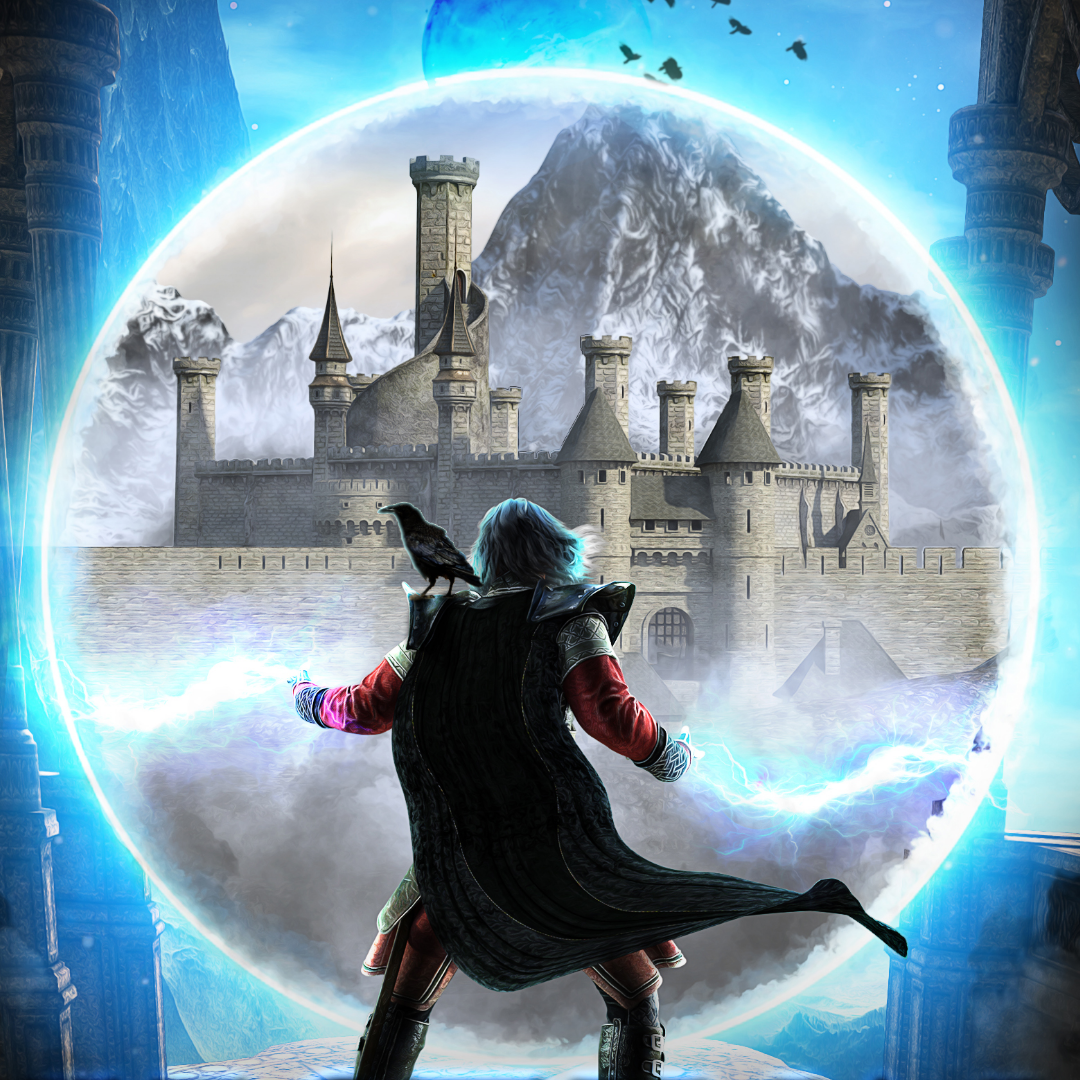Overview
Out of all the different types of magic known to the world of Gaia, evocation is the rarest and least understood. Those born with this gift are known as evokers or invokers depending on the context. Evokers are a highly sought after type of magician who deals with creatures and objects of the Great Beyond by invoking a higher power. They can summon forth spirits of good and evil, ghosts of the recently deceased, and animal guardians to fight by their side.
Divisions of Evocation
The powers an evoker can possess are vast and incredibly difficult to master leaving most evokers incapable of learning everything this division of magic has to offer. As such, there are many subgroups of evokers that dedicate themselves solely to mastering one aspect of evocation. It is not uncommon for a single evoker to dabble in every portion of their gift, but only the greatest evokers can hope to master more than a single subgroup.
Portal Magic
Portal magic is by far the most common division of evocation. Portal magic is true to its name in that its practitioners specialize in teleportation and conjuring portals. Though the processes for opening portals and teleportation may seem similar, there are a few key differences that separate them.
[h4]Teleportation/Self-Summoning [/h4]
Teleportation magic can only be used on the magician casting the spell through a process known as self summoning. This difficult practice requires the portal mage to turn their own summoning ability in on themselves and literally summon themselves to a nearby location. This teleportation is quite accurate, but can only take a single soul and their immediate belongings over relatively short distances with each casting.
As it currently stands, there are only three stable self summoning spells in wide use. The Inner Space Blink spell, Blink for short, is an incredibly short-range teleport used mainly in high-stress situations. Though it can only teleport the user up to 10ft in any direction, its casting time is incredibly quick if used by a practiced evoker, making it the perfect repositioning spell.
The Inner Space Jump spell, Jump for short, allows the evoker to teleport several yards in any direction so long as they have a clear view of where they are going. This spell requires more essence to cast than blink but is far more useful if escape is the primary objective. Its casting time is average to a practiced magician, but masters can zip across the roughest terrains with ease.
The Inner Space Stride spell, Stride for short, allows the evoker to teleport many miles in any direction. Unlike Jump, this spell does not require a clear line of sight. Since teleportation simply cannot function between densely packed atoms, magicians who Stride into a solid surface will simply appear atop it. This carries its own set of risks, but a good portal mage knows not to take a Stride spell lightly. The casting time for this spell is notably long even for seasoned portal mages, so using this spell to escape can be quite difficult, especially if a practiced counter mage is in pursuit.
Portals
Most portal mages typically only dabble in the use of portals since there is little money to be made in self summoning. Portals are created by folding space together to form a closer line between two points. The area between the folds is known as Inner Space.
Whenever a portal is opened, a sphere appears in the intended location and is locked in place by the gravitational pull of the planet the portal was conjured on. This sphere is surrounded on all ends by light, so no matter which way you look at it, the portal appears to be a circle rather than a sphere. Since portals are in fact three dimensional, you can enter or exit a portal from any direction. The portal mage will determine the rotation of the portal. A default portal will have its directions synchronized to the planet beneath it, but a portal mage can invert the direction if they so choose.
For example, A portal mage can create a portal that leads 100 feet in the distance and rotate its direction 180 degrees. Now if you head through the entry portal going north, you will be facing south on the other end. This can be done on any of the three-axis. It is theorized that portals can even be modified to send objects and people forward in time by lengthening the Inner Space corridor, but such tactics would require more essence than most magicians are capable of producing. Only the greatest of portal magicians could ever hope to attempt such an experiment.
The Portal spell is quite flexible in its use. The portal’s size, distance, and lifespan determine precisely how much essence would be required to conjure it. Small portals tend to have very short maximum lifespans compared to larger ones. Once a portal has been opened, it cannot be closed until its lifespan has run its course.
Portals are stable enough when untampered with, but in the presence of other magical stimuli, they can be equated to a gunpowder keg. A single blast of magical energy will react violently with any portal it comes in contact with. The larger the blast and portal, the larger the resulting explosion will be. It is for this reason that portals are not typically used on the battlefield if an artillery magician is present or if the enemy uses explosives.
Summoning/Conjuration
One of the most dangerous and powerful forms of magic is summoning. Evocation existed long before the New Magic came to the world, however it could only be performed in very special places of power. Evokers can now perform conjuration anywhere they can draw the appropriate summoning circles. The beings summoned from the Great Beyond are known as Beyonders. When an evoker summons a Beyonder, they must provide a portion of their own magic reserve to keep the spirit from decaying back into the Great Beyond. There are rituals from the Old Magic that allow certain Beyonders to be summoned permanently without an evoker feeding it magic, but these rituals have long since been banned by the Church of the Holy Trinity. There are many different types of Beyonder that can be summoned, though the means of summoning them can vary.
Animal Guardians
Of all the types of spirits that can be summoned, animal guardians are the easiest to conjure. The souls of animals are less mature than the souls of more conscious beings. The more lives an animal has lived, the more intelligent they can become in their next life until eventually being reincarnated into an intelligent creature. Their immaturity makes them easy to call upon and easier to control once summoned. It is possible to summon an animal guardian on the verge of ascending to a higher form of life. These guardians can learn to speak and are capable of functioning at a humanlike level of intelligence.
Any mundane animal can become an animal guardian, however larger creatures require far more essence to sustain than smaller ones. It is not uncommon for master evokers to have lions and bears as personal bodyguards.
Demons
Any magician with half a brain understands the dangers of summoning demons, but this has not stopped outlaws from researching demonology. Summoning demons is a tricky process that requires another ritual to be performed prior to the demonic conjuring. Unlike other Beyonders, it is rare to find demons who roam free from the reign of a devil. In order to summon most demons, an evoker must first summon a devil and “purchase” the demon in exchange for something the devil considers to be of equal value. Once a bargain has been struck, the devil will lend the demon in question to the evoker to use for the agreed amount of time. The evoker still must provide a portion of their magic reserve to sustain the demon. There are seven types of demons that can be summoned. Lust, gluttony, greed, sloth, wrath, envy, and pride.
Celestials
Not much is known about celestials. As far as the people of Gaia know, celestials are the souls of good people who died and received their eternal reward in Heaven. The general consensus is that these souls cannot be summoned and should not be summoned, for pulling them from eternal paradise would be infinitely cruel.
However, many unorthodox religions claim they can summon their ancestors to bestow special powers upon their descendants if they are found worthy. This practice heavily parallels the Holy Knight baptisms and some secular magicians believe these rituals to be celestial summoning rituals of the Old Magic, though none would ever attempt to publish such a blasphemous paper.
Angels, Devils, and Fairies
Truly skilled evokers with no regard for the laws of Pholton can potentially summon beings of a higher power. Angels, devils, and fairies are immortal Beyonders of such great power that they cannot be enslaved as demons or animal guardians can. When summoned, these beings must have a vessel to possess in order to exist on Gaia for the duration of the rituals. Angels appear before their summoners within their minds, devils possess corpses provided by the evoker, and fairies create a clay or wood avatar out of whatever material is on hand. In these avatar states, these beings are not able to do much more than talk, though it is still possible to make deals with devils while they are summoned.
Binding, Familiarization, and Demonic Union
Once a Beyonder is summoned, the evoker must bind their magic reserve to it in order to keep it from decaying back from whence it came. If the evoker wishes to establish a much deeper link to their summoned Beyonder, they can form a familiarization link with the creature and turn it into a familiar. Familiars can share their senses with their evokers and vice versa. Familiars can communicate with their evoker telepathically from anywhere in the world so long as they live.
Most evokers only create these kinds of bonds with animal guardians, but it is not unusual for a truly deranged evoker to form this kind of link with a demon. If they wish to take this a step further, demonologists can then allow the demon to possess them and form what is known as a demonic union. The evoker accepts whatever corruption the demon brings upon their soul and in exchange, the evoker gains certain increases in power depending on the type of demon. These unions can create immensely powerful magicians, but the corruption they bring is enough to turn even the most pious man into one of the damned.
Exorcism
One of the more common types of evocation is exorcism. By essentially performing the same summoning rituals in reverse, exorcists can call upon the might of a higher being to expel spirits from the bodies of others. In addition to the Exorcism ritual itself, exorcists can use Seals of Protection to force Beyonders within the bounds of a marked room to take on their physical forms wherein a Holy Knight may dispatch them before they can go on a blind rampage. With a bit of prep work, exorcists can give up a portion of their own magic reserves to bestow these seals upon people to protect them from possession. Teams of Holy Knight demon hunters will often have at least two exorcists on hand to even the odds against these overwhelming foes. There is much silver to be made as an exorcist, but the life of a priest is often enough to turn people away from the profession.





